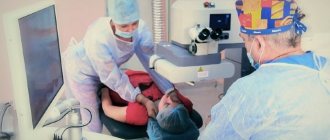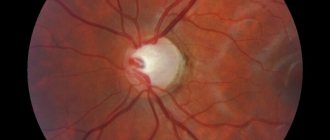Photorefractive keratectomy (PRK) is a common surgical procedure that reshapes the cornea (the clear membrane covering the front of the eye) to improve vision in patients who are farsighted or nearsighted.
PRK differs from other laser eye surgeries because no incisions are made during the procedure. PRK was the first type of refractive eye surgery to use a laser.
Although the excimer laser was developed in the early 1970s and modified for ophthalmic use in the early 1980s, the WHO did not approve its use until 1995.
PRK became less popular after the development of LASIK, a procedure that allowed patients to correct their vision without long recovery periods after surgery.
Advantages of PRK
Approximately 90% of patients have 20/20 vision without glasses or contact lenses one year after surgery. More than 95% have 20/40.
Photorefractive keratectomy is performed in patients with thin corneas, while this is a contraindication for LASIK.
Other benefits:
- lack of flap formation;
- possibility of use in the initial stages of keratoconus;
- used to treat mild to moderate refractive error.
Benefits of LASIK surgery
Laser vision correction LASIK has become so popular in modern society for a reason. It has an impressive number of advantages compared to other types of operations.
For example, during its implementation there is no need for hospitalization. Due to the minimal risk of injury to eye tissue, there is no need to stay in the clinic for more than one day. Most patients go home within a couple of hours after laser correction. Improvement in the quality of vision, as a rule, occurs within a few hours after surgery. However, exact dates cannot be given, since in each specific case the restoration of visual functions occurs individually. The rehabilitation period after surgery is about 2-3 days. After this period of time, the patient can resume work, however, it is first necessary to consult with an ophthalmologist to find out when is the best time to begin work duties. With LASIK, it is possible to correct vision in both eyes at the same time. The operation is performed under local drip anesthesia. This can significantly reduce the risk of allergic reactions, which can often occur after the use of general anesthesia. Tissue restoration after LASIK occurs independently and does not require sutures.
Preparing for surgery
Before excimer laser keratectomy, it is necessary to undergo a thorough examination. 2 weeks before the procedure, stop using contact lenses to allow the cornea to take its natural shape. This is necessary to obtain accurate measurements of the pupils, moisture levels, thickness and curvature of the cornea.
On the day of surgery, do not wear makeup or perfume. Be sure to prepare postoperative medications and read the instructions for their use.
On the day of the procedure:
- eat light food;
- wear comfortable clothes and replaceable shoes;
- arrive at the refractive surgery center 2 hours in advance;
- take an accompanying person with you.
Lasik or femto lasik?
Lasik and femto lasik are modern vision correction techniques that impact the corneal flap, thereby changing its shape and correcting it, which helps improve the clarity of the patient’s vision.
What do the operations have in common?
The methods work on the same principle: a targeted effect on the intermediate area of the cornea, polishing it and, as a result, improving vision. After surgery, as a rule, there is no deterioration in vision, or it is insignificant.
ATTENTION! With these surgeries, it is possible to correct vision in both eyes in one procedure. The techniques correct astigmatism, myopia and farsightedness.
Differences
- With the Lasik technique, the operation is performed using a medical instrument - a microkerat. It is used to separate the required layer of epithelium, and then use laser beams to influence its shape.
- With the femtolasik (knifeless) technique, only lasers are used, two types:
- Femtosecond is a high-precision device that creates the thinnest corneal layer of the required thickness;
- Excimer laser is a laser that resurfaces the surface of the cornea and changes the radius of its curvature.
Price difference
Lasik: If we take the price for both eyes with myopia up to -4 d, then it will be equal to 60 thousand rubles.
Femto Lasik: For the same myopia, the price will be 110 thousand rubles for both eyes.
IMPORTANT! For higher myopia or astigmatism, the cost of the procedure will be approximately 20% higher.
How is the operation performed?
The vision correction procedure has been successfully performed for many years. It is carried out in several stages:
- Instillation of anesthetic drops.
- Removal of the top layer of the cornea. The surgeon needs access to the stromal layer. Removing the top layer exposes the stroma, where the cornea must remodel to correct vision.
- Formation. The laser changes the shape of the stroma required for a particular patient with an accuracy of 1 micron, which is 1/1000 mm.
- The eyes are washed with an antiseptic solution and an artificial protective lens is installed.
LASIK OR SUPER LASIK: comparison of laser vision correction methods
The growth of pathologies of the visual apparatus is due to increased load during daily human activities. Refractive errors are divided into the following types:
- nearsightedness (myopia);
- farsightedness (hypermetropia);
- astigmatism.
Ophthalmologists around the world are introducing laser vision correction into their practice, which helps restore visual function by changing the shape of the cornea. Various types of techniques allow us to personalize the approach to each patient, taking into account individual characteristics to achieve maximum effect.
History of the development of laser correction
A common precursor to modern techniques is PRK (photorefractive keratectomy). The essence of the method is a superficial effect on the cornea of the eye. The epithelial layer is removed, and a lens is formed on the cornea. However, on the surface of the eyeball there remains an area not covered by epithelium - a wound that causes discomfort over the next few days. This method is leaving the practice of doctors and is quite rare.
The history of Lasik begins in 1950, when the microkeratome was first created and laser keratomileusis was performed. In the 70s, the first excimer laser was developed for ablation of stratum corneum tissue. In the late 80s, a technique for changing the curvature of the cornea was patented. Since the 90s, the Lasik technique has been introduced in Western countries and the post-Soviet space. The great contribution of domestic ophthalmologists to the history of the development of eye microsurgery is noted. Laser correction technology has improved every year and celebrated its 20th anniversary in 2010.
Comparison of techniques
Modern technologies Lasik and SuperLasik are based on working with the inner layers of the cornea. The primary flap is created using a femtosecond infrared laser. The ability to combine laser and mechanical effects makes the procedure more accurate and safe. As a result of the influence of high-tech equipment, it is possible to adjust the thickness and diameter of the cut, implantation of stromal rings and layer-by-layer plastic surgery of the cornea. In this case, fixation occurs at any depth with minimal damage to the morphological structure of the eye tissues. Gentle surgical intervention does not require a rehabilitation period and returns visual acuity in a few days. The effect of the procedure lasts for life and does not require additional or repeated interventions.
Indications for implementation:
- image focus in front of the retina – myopia (-15 diopters);
- image focus behind the retina – hypermetropia (+6 diopters);
- focus in several places at the same time - astigmatism (from -6 to +6 diopters).
Lasik correction
Laser keratomileusis is performed in 2 stages. First, the patient receives local anesthesia. At stage 1, using a mechanical microkeratome device or a femtosecond laser, the surface layer of the corneal epithelium is isolated. A flap is formed from it, which is connected to the cornea at one edge and is subsequently returned back. The flap has the same thickness throughout its entire length, the approximate standard diameter is up to 8 mm. Direct laser vision correction is performed in stage 2 of the procedure. An automated excimer laser shapes the lens onto the cornea so that the image is projected precisely onto the retina. The flap is then returned to its location and heals through adhesion. Microsurgical surgery does not use sutures and leaves no scars, so there is no discomfort or recovery period after the procedure.
Main advantages:
- Lasik technique is minimally invasive and painless;
- leaves no consequences;
- duration – 15-20 minutes;
- the effect lasts a lifetime;
- accurate calculations are made;
- automated equipment has no errors.
SuperLasik correction
SuperLasik is a modernized version of the Lasik technique and is suitable for complicated cases of refractive error. SuperLasik is preferred in the following cases:
- higher order aberrations;
- violations of contrast and color perception;
- twilight vision pathologies;
- the presence of glare and halos;
- non-standard pupil diameter;
- spasm of accommodation.
Like Lasik, the operation is performed in 2 stages. The distinctive feature of the technique is a more accurate correction of the optics of the eye. Due to aberration diagnostics, the process takes into account the minimal structural features of the cornea and eliminates its defects. Correction allows you to restore not only lost visual acuity, but also its quality (increase sharpness, brightness and contrast, eliminate diplopia). The procedure is also indicated for people with consequences of previous surgical interventions. All data is entered into a computer, which personally calculates the volume of the operation and corrects distortions of the visual apparatus.
Thus, these procedures are widely used to improve visual acuity, SuperLasik also corrects the quality of vision. The main advantages are speed, painlessness, absence of discomfort and rehabilitation period. The techniques are carried out using innovative technologies and provide high accuracy and lasting results without health risks.
The Oculus Eye Microsurgery Clinic actively uses modern laser treatment techniques. Thousands of people got the opportunity to see the world from a different perspective without glasses or lenses. The clinic has extensive experience in refractive treatment of vision anomalies. Our specialists provide consultations at your appointment and use additional accurate diagnostic methods to select the optimal treatment and achieve your desired result.
Rehabilitation after PRK
After completing the procedure, the surgeon will apply a blindfold, which you will need to wear for the next 3-4 days. During this time, moisturizing eye drops are prescribed to help reduce discomfort, heal the cornea faster, and reduce the risk of scarring and infection.
Sunglasses are worn after PRK. This is because sun exposure can cause scarring on the cornea after surgery, causing vision problems.
Restrictions after the procedure:
- avoid getting water into your eyes in the first week after the procedure;
- do not rub your eyes;
- do not visit the spa, sauna, solarium for 2 weeks;
- do not apply makeup for the first 7 days;
- Read and watch TV for at least the first 2 days.
Sunglasses must be worn outdoors.
What are the possible complications after correction?
Before the operation begins, the ophthalmologist who will perform it will definitely warn the patient about possible discomfort after its completion. For example, the eyes may become watery and there may be an itching or burning sensation. The first few hours after laser vision correction may cause glare, increased sensitivity to light, or discomfort from installing an eyelid speculum.
However, such discomfort is an absolutely normal consequence of vision correction using the LASIK method. Serious complications after surgery are quite rare, but they cannot be completely excluded. It can be:
- astigmatism;
- keratoconus;
- dry eye syndrome;
- insufficiently accurate vision correction;
- displacement of the corneal flap.
If the first symptoms occur, you should immediately contact the clinic where the operation was performed or your attending ophthalmologist.
Complications
Common side effects include discomfort, dry eyes, foreign body sensation, blurred vision, and halos around lights. These symptoms usually disappear as the eyes heal. Recovery of vision takes several days, and final visual acuity stabilizes after several months.
Complications include:
- scars on the cornea;
- infections;
- improperly formed cornea;
- ectasia is a condition characterized by softening of the cornea;
- increased intraocular pressure (sometimes associated with the use of steroid eye drops in the postoperative period);
- persistent erosion.
These complications lead to blurred vision, blindness, pain, and increased sensitivity to light.
What is LASIK?
LASIK, or laser assisted keratomileusis, is a surgical procedure to correct nearsightedness, farsightedness and astigmatism. During this procedure, the surgeon makes an incision on the cornea, thus obtaining a flap from its surface layer. The doctor moves it to the side and uses a laser to evaporate the deep stroma, that is, changes the shape of the cornea, correcting the refractive error. After this, the flap is returned to its original place.
The operation is completely painless. Visual functions are restored within a few hours. The likelihood of complications is very low. It is important to follow all doctor’s recommendations during the rehabilitation period. However, complications are still possible. They appear as:
- deformation of the flap due to trauma, touch;
- clouding of the cornea;
- inflammation;
- protrusion of the cornea, keratoconus.
The LASIK method has a number of limitations. It is impossible with a thin cornea. It cannot correct severe myopia. LASEK can eliminate these shortcomings.
Which is better - PRK or Lasik?
LASIK consists of creating a corneal flap using a device called a microkeratome. A microkeratome is a mechanical device that uses a blade or laser beam. After creating the flap, the excimer laser removes a small amount of tissue from the exposed cornea. After laser treatment, the flap is applied to the eye. PRK consists of mechanical removal of superficial epithelial cells.
The main advantage of LASIK is rapid healing and absence of discomfort. Vision is restored on the day of refractive surgery.
After photorefractive keratectomy, recovery is longer, so this method is used less frequently than LASIK.
There may be mild discomfort during the first few days after PRK. It will take 7–10 days to restore vision, in rare cases more. If the result of the procedure does not meet expectations, a repeat operation may be performed. Essentially, this will be the same process as the original operation.
LASIK has more benefits and fewer postoperative complications. This procedure is considered better.
PRK – Photorefractive keratectomy
PRK surgery was the first laser surgery used to correct vision in humans, back in 1985. This technology uses an excimer laser, with the help of which, using a cold ultraviolet beam, the corneal tissue is evaporated to the required size, under computer supervision. This method is used in cases of: myopia (-1.0 – -6.0 diopters), farsightedness (up to +3.0 diopters), astigmatism (-0.5 – -3.0 diopters). It consists of several stages:
- local anesthesia is used (in the form of eye drops), alcohol is used to soften the epithelium, the eyelid and eye are fixed using an eyelid expander, and sometimes with a vacuum ring;
- remove the epithelium using a microsurgical spatula;
- the cornea is corrected using an excimer laser;
- After correction, the cornea is treated with an alcohol solution, antibacterial drops are instilled, and then a special lens is placed that will protect the cornea while the epithelium is restored.
Advantages of PRK
- non-contact method of treatment;
- performing the operation in one day;
- after the operation, clarity of vision is guaranteed;
- during the recovery period, a consistently predictable result;
- no pain;
- no significant likelihood of negative events during and after the procedure;
- admissibility of using the technology with a thin cornea.
Disadvantages of PRK
- long rehabilitation period;
- painful, unpleasant sensations during the rehabilitation period;
- temporary unstable clouding of the surface layer of the cornea (Hayes);
- sometimes there are small inaccuracies in the correction (0.25 - 0.75 diopters).
Patient reviews
Larisa: I had vision correction performed at a specialized ophthalmology center. I was pleased with the result. Vision quickly recovered, but was blurred for some time. 5 years have passed, no complications. Vision is good in bright light and at night.
Yana: I chose photorefractive keratectomy based on excellent reviews from several ophthalmologists with whom I was examined. The operation went quickly. The only drawback is that it takes a long time to heal; I found out later that LASIK is better and the recovery is faster. But I was still satisfied with the procedure. The most unpleasant thing is the dilator that is installed in the eyes.
Indications for laser correction
Surgery using a laser beam is only possible if the patient is over 18 years of age. Doctors explain this by saying that it is after reaching this age that the eyeball finishes forming. The main indications for
- LASIK vision corrections are:
- myopia no more than 10 diopters;
- farsightedness no more than 6 diopters;
- astigmatism up to 3 diopters.
In addition, correction of visual impairment is recommended for those patients who experience certain difficulties when using contact optics or glasses due to their professional activities. In particular, representatives of such professions as:
- firefighters;
- military personnel;
- pilots.
This also applies to all those who are forced to work in conditions of constant smoke, gas or dust, as well as in chemical production. Individual exceptions are also possible, however, in most of them we are talking about partial restoration of vision. That is why it is strongly recommended to visit an ophthalmologist before undergoing surgery.
What's better?
The patient can choose the appropriate method of vision correction. In difficult situations, the doctor prescribes the procedure independently.
FemtoLASIK is considered a gentle approach because it occurs without the intervention of a surgeon. The operation is performed using a femtolaser at the initial stage to separate the outer layer of the cornea. Next, the excimer laser acts on the deeper shells, they acquire the desired appearance. After manipulation, the corneal layer is returned back. This technique is safer and reduces many possible risks due to improved technology.










